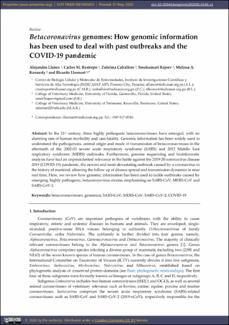Mostrar el registro sencillo del ítem
Betacoronavirus genomes: How genomic information has been used to deal with past outbreaks and the COVID-19 pandemic
| dc.contributor.author | Llanes, Alejandro | |
| dc.contributor.author | Restrepo, Carlos M. | |
| dc.contributor.author | Caballero, Zuleima | |
| dc.contributor.author | Rajeev, Sreekumari | |
| dc.contributor.author | Kennedy, Melissa A. | |
| dc.contributor.author | Lleonart, Ricardo | |
| dc.date.accessioned | 2020-06-26T23:56:31Z | |
| dc.date.available | 2020-06-26T23:56:31Z | |
| dc.date.issued | 2020-05-27 | |
| dc.identifier.other | doi: 10.20944/preprints202005.0448.v1 | |
| dc.identifier.uri | http://repositorio-indicasat.org.pa/handle/123456789/124 | |
| dc.description | In the 21st century, three highly pathogenic betacoronaviruses have emerged, with an alarming rate of human morbidity and case fatality. Genomic information has been widely used to understand the pathogenesis, animal origin and mode of transmission of betacoronaviruses in the aftermath of the 2002-03 severe acute respiratory syndrome (SARS) and 2012 Middle East respiratory syndrome (MERS) outbreaks. Furthermore, genome sequencing and bioinformatic analysis have had an unprecedented relevance in the battle against the 2019-20 coronavirus disease 2019 (COVID-19) pandemic, the newest and most devastating outbreak caused by a coronavirus in the history of mankind, allowing the follow up of disease spread and transmission dynamics in near real time. Here, we review how genomic information has been used to tackle outbreaks caused by emerging, highly pathogenic, betacoronavirus strains, emphasizing on SARS-CoV, MERS-CoV and SARS-CoV-2. | en_US |
| dc.description.abstract | In the 21st century, three highly pathogenic betacoronaviruses have emerged, with an alarming rate of human morbidity and case fatality. Genomic information has been widely used to understand the pathogenesis, animal origin and mode of transmission of betacoronaviruses in the aftermath of the 2002-03 severe acute respiratory syndrome (SARS) and 2012 Middle East respiratory syndrome (MERS) outbreaks. Furthermore, genome sequencing and bioinformatic analysis have had an unprecedented relevance in the battle against the 2019-20 coronavirus disease 2019 (COVID-19) pandemic, the newest and most devastating outbreak caused by a coronavirus in the history of mankind, allowing the follow up of disease spread and transmission dynamics in near real time. Here, we review how genomic information has been used to tackle outbreaks caused by emerging, highly pathogenic, betacoronavirus strains, emphasizing on SARS-CoV, MERS-CoV and SARS-CoV-2. | en_US |
| dc.language.iso | eng | en_US |
| dc.rights | info:eu-repo/semantics/openAccess | |
| dc.subject | betacoronaviruses | en_US |
| dc.subject | genomics | en_US |
| dc.subject | SARS-CoV | en_US |
| dc.subject | MERS-CoV | en_US |
| dc.subject | SARS-CoV-2 | en_US |
| dc.subject | COVID-19 | en_US |
| dc.title | Betacoronavirus genomes: How genomic information has been used to deal with past outbreaks and the COVID-19 pandemic | en_US |
| dc.type | info:eu-repo/semantics/article | en_US |
| dc.type | info:edu-repo/semantics/publishedVersion |

